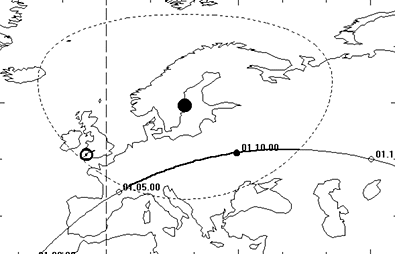 |
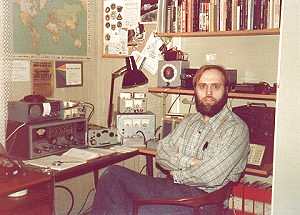 After
the launch of Salyut 3 on June 24, 1974, the Kettering
Group scrambled to the radios to try to pick up signals. But, just
as was the case with Salyut 2, nothing was heard on the typical
frequencies
used by Soyuz and Salyut 1. We feared the worst - to be cut off from
all
radio communications with a major Soviet space mission. When I talked
to
Geoff Perry in the evening of June 27 he said: "Maybe we have been
stupid.
Perhaps the item in Aviation Week should be read without any prejudice.
Maybe it refers to short-wave recon-satellite signals being similar to
Salyut 2 telemetry". The Aviation Week article he referred to was
published
on September 3, 1973 and reads as follows:
After
the launch of Salyut 3 on June 24, 1974, the Kettering
Group scrambled to the radios to try to pick up signals. But, just
as was the case with Salyut 2, nothing was heard on the typical
frequencies
used by Soyuz and Salyut 1. We feared the worst - to be cut off from
all
radio communications with a major Soviet space mission. When I talked
to
Geoff Perry in the evening of June 27 he said: "Maybe we have been
stupid.
Perhaps the item in Aviation Week should be read without any prejudice.
Maybe it refers to short-wave recon-satellite signals being similar to
Salyut 2 telemetry". The Aviation Week article he referred to was
published
on September 3, 1973 and reads as follows:
"Soviet penchant for secrecy within its own space program has lead to a widespread, but erroneous, belief that a Salyut spacecraft failed while in orbit. The spacecraft, which the Soviet press and information agencies called a Salyut, was launched Apr. 3 and apparently suffered a catastrophic failure on Apr. 14. However, the spacecraft transmitted on a different frequency than previous Salyuts and now is believed to have been a different spacecraft. The reports initially issued by the Soviets apparently were incorrect because of an attempt to keep secret the actual nature of the spacecraft. Telemetry transmission from the spacecraft were similar to those monitored earlier from Soviet reconnaissance satellites."
Geoff Perry suggested
we
should try 19.150 MHz, 19.990 MHz and 19.994 MHz. I agreed, and set the
alarm clock for 0045 UT to catch a close pass of Salyut 3. The
frequency
band 19-20 MHz was almost "dead" that night, i.e. no long-range
propagation
of signals. This meant that any signals from Salyut 3 would only be
audible
while over the horizon in Stockholm, and there were almost no other
stations
that could interfere. It ought to be easy to find the signal. I slowly
tuned up from 19 MHz, and at 0107:45 UT I suddenly picked up the
typical
FSK-PDM
signals
similar to those from 12-day Cosmoses and Proton satellites and Cosmos
110 (listen here
for
a sample of Almaz shortwave telemetry - in this case from Salyut-5, Feb
9, 1977). The signal grew in strength and finally faded out at
0112:50
UT. I measured the frequency with the WW II BC-221 frequency meter to
be
19.946 MHz. (later determined to be 19.944 MHz) Both the frequency and
signal format was different from Salyut 1. (You can see a picture of me
at my radios in 1974 above right).
 |
Salyut 1 was on 15.008
MHz
and 20.008 MHz and used CW-PDM,
i.e. a carrier that was keyed on and off where the length of the ON
periods
represent telemetry values. Even though this discrepancy was obvious
and
the mysterious Kosmos 557, which everyone thought was a failed Salyut
used
15.008 MHz and 20.008 MHz like Salyut 1, we still hesitated to divide
the
Salyut series into two distinct groups or categories.
The fact that Geoff Perry computed launch at 1853 UT and signals at 1902 UT was due to the fact that he used a zero-rev equator crossing of 348 degrees and had an inaccurate orbit for Salyut-3. |
On July 3, myself and Geoff Perry in Kettering switched on our radios. I started monitoring shortwaves at 1845 UT and promptly picked up Salyut-3 on 19.944 MHz at 1846-1856 UT. I then switched to the typical Soyuz frequency 20.008 MHz expecting signals about 9 minutes after launch when the shortwaves antennas deployed. I heard the typical beep-beep from a Soyuz at 1901.50 UT. The signal was weak, but clear. It faded out at 1903 UT. So, after a long wait, a Soyuz was on its way to a Salyut space station again. I called Geoff Perry who had heard the signal also, and we agreed that he should put out a brief message to the media to the effect that "Signals picked up this evening in Stockholm and Kettering suggest that the Soviet Union launched a Soyuz spacecraft at 1853 Z, presumably to rendezvous with the space station Salyut-3 launched on 24 June".
About an hour after launch, at 1957.02 UT, I picked up the short-wave telemetry from Soyuz-14 again. The PDM word number 8 varied between two values: short and medium length. The number of levels between which this word varied was an indication of the number of crew members. We had learned this during the flight of Soyuz-4 and -5 five years earlier. So, the spacecraft had a crew of two. I told everyone that cared to know; Geoff, local newspapers... .
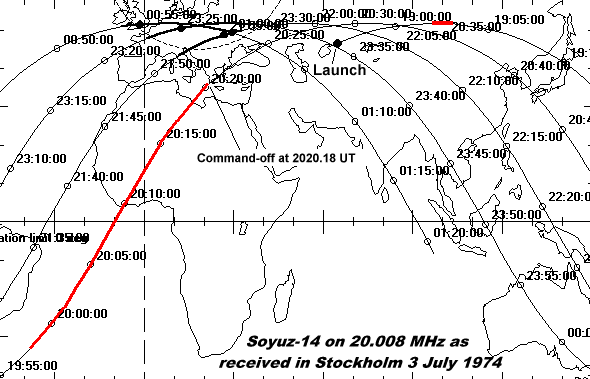
I had never really picked up clear voice from a Soviet spacecraft before, so now was my chance. I had no permanent antenna installed, so the Yagi for the Soyuz voice frequency was mounted on a broomstick tied to the balcony of my apartment. The 922 MHz helix was on a camera tripod. At 2154.25 UT voice signals came through from Soyuz-14, and after a while the crew could be heard calling: "Zarya ya Berkut, pryom" (Dawn this is Golden Eagle, over). I thought that I remembered who had this call sign, and it did not take me long to look up That "Berkut" had been used by Pavel Popovich! Moscow still had not announced the flight. So, before the official announcement we knew that the Soyuz had been launched, we knew that it had a crew of two and that the commander was Pavel Popovich - not a bad feat of radio sleuthing - if I may say so!
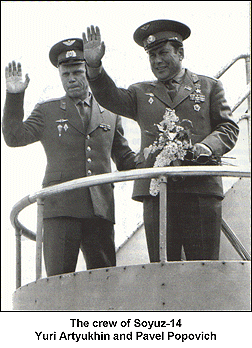 The
news bulletin issued by Geoff Perry was read at 2200 UT in the newscast
by Independent Television News from London. Mr. Peter Griffiths of
Reuters,
upon hearing the ITN news item sent a service message to Moscow: "Please
check ITN story". He thereafter talked to ITN
and
obtained Mr. Perry's phone number and after having talked to Geoff
Perry,
Reuters issued the following news item at 2300 UT:
The
news bulletin issued by Geoff Perry was read at 2200 UT in the newscast
by Independent Television News from London. Mr. Peter Griffiths of
Reuters,
upon hearing the ITN news item sent a service message to Moscow: "Please
check ITN story". He thereafter talked to ITN
and
obtained Mr. Perry's phone number and after having talked to Geoff
Perry,
Reuters issued the following news item at 2300 UT:
Kettering,
England
"British
space watchers reported tonight they have monitored signals indicating
the Soviet Union launched a two man spacecraft today. School Science
master
Geoff Perry, whose observations have proved accurate in the past, said
he and colleagues working in Sweden believe a Soyuz spacecraft was
launched
at 1853 UT. Mr. Perry who runs a space monitoring service at a school
in
this English Midlands town, said he had picked up radio and voice
signals
that were unmistakably from a new Soviet space vehicle with men aboard".
As a result of their call to Moscow, Reuters issued this message at 2335 UT:
Moscow,
4 July (Moscow Time)
"The
Soviet Union launched a manned Soyuz spacecraft, apparently to link up
with the Salyut-3 space station put into orbit on June 25, an official
Soviet source said here today. A spokesman for the state-controlled
committee
for radio and television, asked if there had been a Soyuz launched,
said
'Yes, they have put one up'.
She declined to say when the craft had been launched, but a British
space
watcher said he and a colleague in Sweden believed the craft was put in
orbit at 1853 UT yesterday."
After the initial voice signals from Soyuz-14 more voice receptions and carrier with telemetry sidebands on 922.75 MHz were made at 2325-2328.30 UT on 3 July and again at 0056-0059.30 UT on 4 July.
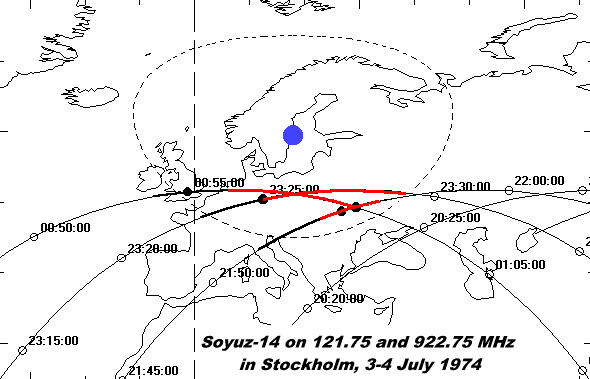
After this pass no coverage was possible from Europe and the tracking "baton" passed to Dick (Richard) Flagg in Gainesville Florida. Dick was notified by Jim Oberg at 0120 UT that Geoff Perry had announced the launch. Dick promptly picked up the Soyuz-14 radio beacon on 20.008 MHz at 0158 UT while simultaneously hearing the Salyut-3 short-wave beacon on 19.944 MHz. Soyuz-14 came back on shortwaves at 0334 UT and finally, at 0347.50-0349.00 UT Dick picked up the signal on 922.75 MHz - so there was a Soviet tracking ship in the vicinity!
Finally, at 0400 UT, Radio Moscow announced the flight confirming that Pavel Popovich was indeed the commander of the flight accompanied by Yuri Artyukhin!
After this success Dick went to sleep to catch the southbound passes near Florida later in the day. At 1006-1011 UT he picks up voice on 121.75 MHz where "Berkut" calls "Komarov" - so the tracking ship Vladimir Komarov was out. On the next pass strong signals both on 922.75 MHz and voice on 121.75 MHz - again with "Berkut" calling "Komarov" and saying that everything is fine and that the crew had eaten a snack. By plotting the receptions made in Florida it seems that two tracking ships were active. One along the northern part of the U.S. Eastern seaboard and one off Cuba. The one off Cuba was obviously the tracking ship Vladimir Komarov and it later turned out that the ship up north was the Yuri Gagarin.
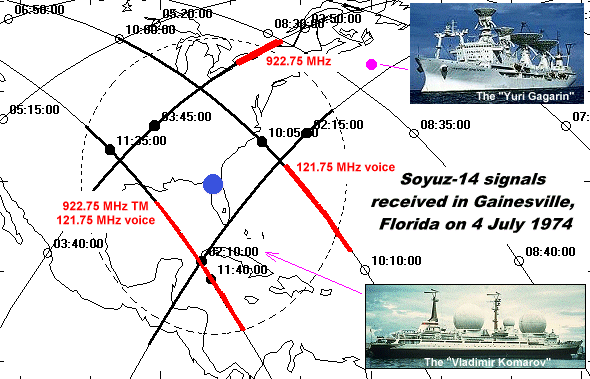
"Yes we are in our flight suits.....what are you speaking about?...the telemetry is it?....Oh, you have in min on Salyut-3 that is? Yura, look on Salyut-3 and see if the telemetry is turned on....all is turned on ... everything is normal...Berkut 2 did not change anything absolutely....".
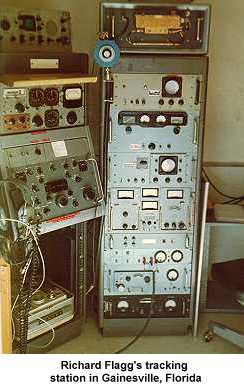 After
this reception all signals from Soyuz-14 on 20, 121 and 922 MHz ceased
and the Kettering Group was left with only the short-wave beacon from
Salyut-3.
After
this reception all signals from Soyuz-14 on 20, 121 and 922 MHz ceased
and the Kettering Group was left with only the short-wave beacon from
Salyut-3.
Many years later we learned that George Bailey in Sherwood Arkansas had picked up AM voice on 20.008 MHz later on 5 July as the space station streaked across the U.S. Midwest. "Berkut-2", i.e. Artyukhin called "Vjezna" (Springtime) and complained that he received Vjezna "very poorly". George's reception took place when the space station was over his horizon (see map). Interestingly, Dick Flagg in Florida had monitored the previous pass over the U.S. on 20.008 MHz without hearing anything. Dick had gone off watch when George picked up this remarkable transmission at 1135-1137 UT. Why the crew used the short-wave transmitter on the Soyuz (presumably) more than 12 hours after docking to Salyut is unclear. Also, on this particular pass they must have been able to talk directly via VHF to the ship in the Caribbean. Maybe, it was just a test to see that this back-up link worked. "Vjezna" was used during all the early Vostok and Voskhod flights as the call sign for ground stations operating on shortwaves. In those days there were several ground stations using this call-sign, so they used numbers like "Vjezna-3" etc.. George Bailey's reception is the last known short-wave voice from a Soviet spaceship where the call-sign Vjezna was used.
However, quite clearly Salyut-3 did not use the same VHF frequencies as the Soyuz and the Kettering Group started searching the wavebands for voice. Three frequencies were selected for this search; 142.4 MHz (known to be planned for ASTP), 183.6 MHz (a Soviet lunar probe frequency) and 143.6 MHz (used by the Vostoks). Jan-Ola Dahlberg in Malmö, Sweden took on the search on 143.6 MHz using an old 2-meter band amateur converter into his Drake receiver and detected voice signals on 143.625 MHz from Salyut-3 at 2140 UT on 6 July 1974. Only two stations in the Kettering Group were immediately equipped to properly demodulate the wideband FM signals on this frequency: Kettering and Gainesville. Actually, Dick Flagg built a frequency converter to work with his R-390 receiver and a 16 kHz wide phase lock loop detector. He did this in just two days after having been informed about the new frequency on 9 July (the telegram informing him of the new frequency got lost - remember, this was twenty years before the Internet). The first recording he made at 0813 UT on 9 July is somewhat revealing - dealing with film cassettes:
"...And in the second place there is a problem with the tape. The tape has run out after 50 seconds on the film and we don't know where it stopped because on the counting instrument we are located on 90. We don't have anymore white tape. My tape has run out on the black cassette, there is no more tape. Can we turn from the black cassette to the white?...."
So, the old Vostok voice frequency was in use and the Kettering station kept receiving good voice from Salyut-3 throughout the Soyuz-14 mission.
Expecting the mission to end I monitored the 20.008 MHz beacon frequency of Soyuz-14 on 19 July 1974 and picked it up just before noon UT. During the transmission it was obvious that word 7 on the PDM telemetry frame was "long", something we had learned in the past signaled immediate re-entry! The signal was commanded off at 1150.45 UT. By using the rule-of-thumb that the landing occurs 30 minutes after loss-of-signal I could tell the Swedish news agency TT that the landing would occur at 1220 UT when I called them at 1201 UT. TASS later announced that Pavel Popovich and Yuri Artyukhin had landed near Dzjezkazgan in Kazakhstan at 1221:36 UT!
However, when I returned home on 17 July 1976, I discovered a peculiar thing about the voice link on 143.625 MHz. During the pass over Europe at 1309-1313 UT the carrier on 143.625 MHz came on for 15 seconds to be replaced for the remainder of the pass by a noise spectrum with two distinct peaks about 200 kHz apart. One of the peaks was spot on 143.625 MHz while the other was about 200 kHz higher. The following day, 18 July, two out of four passes of Salyut-5 had normal voice and the other two had the noise modulation. The noise modulation came back on one pass per day on the following dates: 20 July, 21 July, 22 July, 23 July, 6 August, 7 August, 8 August, 21 August, and 23 August. (See article "Salyut-5 voice recordings") On all other passes there was normal frequency modulation with clear voice. (Strangely enough Salyut-5 continued to transmit carrier on 143.625 MHz until 4 September 1976 although the crew had landed on 24 August!)
In my log for 17 July
1976
I also noted that one of the noise peaks seemed to be keyed on-off as
if
transmitting Morse code! During the flight of Soyuz-24 the noise
transmissions
on 143.625 MHz continued and I logged this on 7 occasions out of 20
reception
in total on this frequency. What could this noise modulation be but
scrambling
to hide the secret nature of the station's mission?
While I was Florida we consistently monitored this transmitter to be on 181.0 MHz and I measured the frequency to be 181.0 MHz when tracking from Stockholm after my return from the U.S. However, on 7 August 1976, I noticed that the frequency had changed to 180.0 MHz, and on 19 August I could hear the frequency of the transmitter change from 181 to 180 MHz during a pass. Later, the frequency remained on 180.0 MHz. Was there an unstable transmitter?
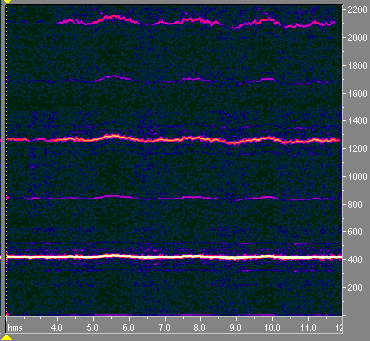 Undoubtedly
the 180/181 MHz transmitter was the main telemetry link for the station
and it turned out that the "civilian" Salyut stations had a PPM-AM
telemetry
transmitter in the same band (166.0 and 192.0 MHz). But, the civilian
stations
had a command verification downlink on 922.75 MHz (and an uplink at
768.96MHz).
Where was the corresponding link for the Almaz stations? I do not know
for sure, but the TKS spacecraft, one of which nowadays flies in space
as the ISS module Zarya uses a military command system called Komparus
which has its command uplink in the 7.2 GHz band, and a command
verification
downlink at about 2.37 GHz. Maybe this system was also used for the
Almaz
stations.
Undoubtedly
the 180/181 MHz transmitter was the main telemetry link for the station
and it turned out that the "civilian" Salyut stations had a PPM-AM
telemetry
transmitter in the same band (166.0 and 192.0 MHz). But, the civilian
stations
had a command verification downlink on 922.75 MHz (and an uplink at
768.96MHz).
Where was the corresponding link for the Almaz stations? I do not know
for sure, but the TKS spacecraft, one of which nowadays flies in space
as the ISS module Zarya uses a military command system called Komparus
which has its command uplink in the 7.2 GHz band, and a command
verification
downlink at about 2.37 GHz. Maybe this system was also used for the
Almaz
stations.